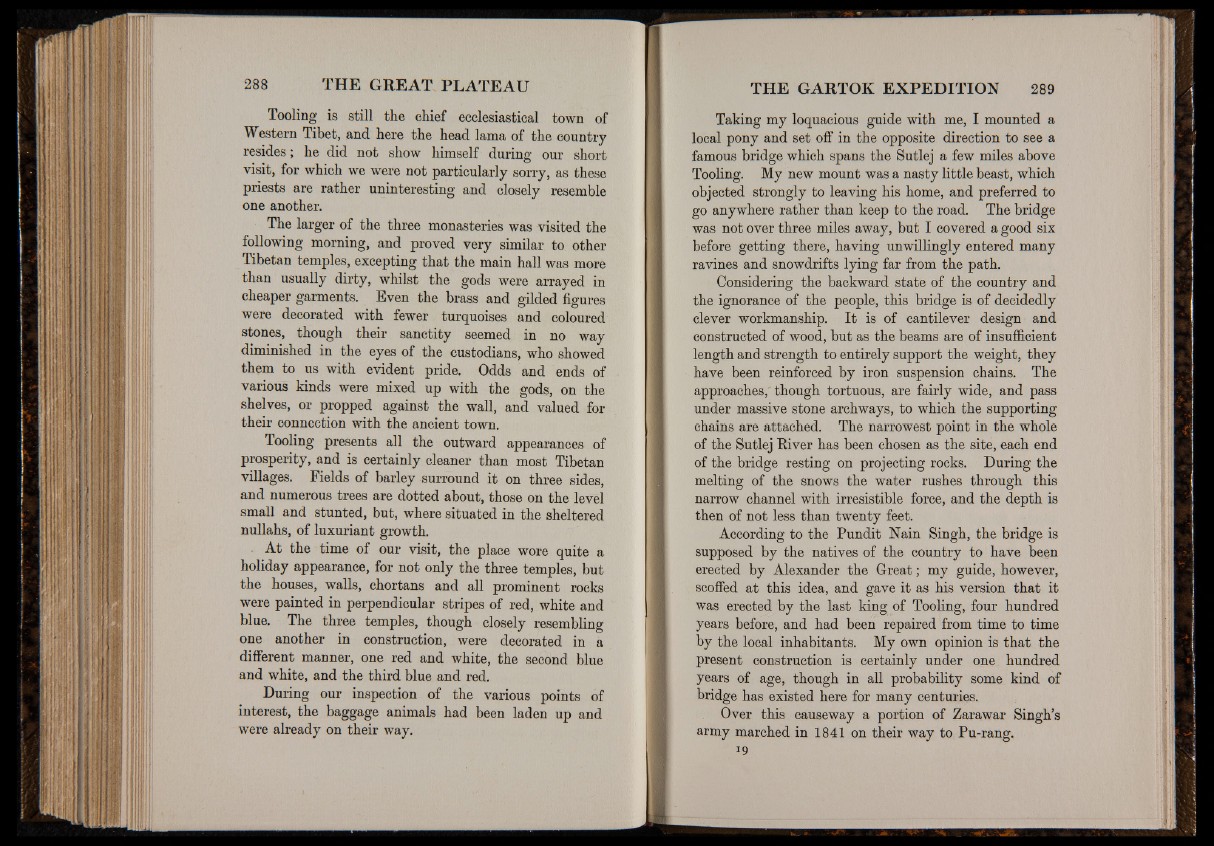
Tooling is still the chief ecclesiastical town of
Western Tibet, and here the head lama of the country
resides ; he did not show himself during our short
visit, for which we were not particularly sorry, as these
priests are rather uninteresting and closely resemble
one another.
The larger of the three monasteries was visited the
following morning, and proved very similar to other
Tibetan temples, excepting that the main hall was more
than usually dirty, whilst the gods were arrayed in
cheaper garments. Even the brass and gilded figures
were decorated with fewer turquoises and coloured
stones, though their sanctity seemed in no way
diminished in the eyes of the custodians, who showed
them to us with evident pride. Odds and ends of
various kinds were mixed up with the gods, on the
shelves, or propped against the wall, and valued for
their connection with the ancient town.
Tooling presents all the outward appearances of
prosperity, and is certainly cleaner than most Tibetan
villages. Fields of barley surround it on three sides,
and numerous trees are dotted about, those on the level
small and stunted, but, where situated in the sheltered
nullahs, of luxuriant growth.
At the time of our visit, the place wore quite a
holiday appearance, for not only the three temples, but
the houses, walls, chortans and all prominent rocks
were painted in perpendicular stripes of red, white and
blue. The three temples, though closely resembling
one another in construction, were decorated in a
different manner, one red and white, the second blue
and white, and the third blue and red.
During our inspection of the various points of
interest, the baggage animals had been laden up and
were already on their way.
Taking my loquacious guide with me, I mounted a
local pony and set off in the opposite direction to see a
famous bridge which spans the Sutlej a few miles above
Tooling. My new mount was a nasty little beast, which
objected strongly to leaving his home, and preferred to
go anywhere rather than keep to the road. The bridge
was not over three miles away, but I covered a good six
before getting there, having unwillingly entered many
ravines and snowdrifts lying far from the path.
Considering the backward state of the country and
the ignorance of the people, this bridge is of decidedly
clever workmanship. It is of cantilever design and
constructed of wood, but as the beams are of insufficient
length and strength to entirely support the weight, they
have been reinforced by iron suspension chains. The
approaches, though tortuous, are fairly wide, and pass
under massive stone archways, to which the supporting
chains are attached. The narrowest point in the whole
of the Sutlej River has been chosen as the site, each end
of the bridge resting on projecting rocks. During the
melting of the snows the water rushes through this
narrow channel with irresistible force, and the depth is
then of not less than twenty feet.
According to the Pundit Nain Singh, the bridge is
supposed by the natives of the country to have been
erected by Alexander the Great; my guide, however,
scoffed at this idea, and gave it as his version that it
was erected by the last king of Tooling, four hundred
years before, and had been repaired from time to time
by the local inhabitants. My own opinion is that the
present construction is certainly under one hundred
years of age, though in all probability some kind of
bridge has existed here for many centuries.
Over this causeway a portion of Zarawar Singh’s
army marched in 1841 on their way to Pu-rang.
*9